New York Times “Designer Dogs”
In the proud and punctilious history of purebred dog breeding — which has policed the sex lives of dogs with unbending vigilance since the Victorian era — the mongrel has been regarded as, at best, an unfortunate accident and, at worst, a disgrace. Yet one rainy morning last fall, Wallace Havens (Puppy Mill owner) walked the long aisles of his kennel, introducing me to his newest mutts as though enumerating miracles.
Unlatching a cage door, Havens would cradle a puppy against his fuchsia cowboy shirt and announce: “Well, here’s a Shih Tzu crossed with a Havanese” or “Here’s a silky crossed with a Yorkie.” Then he would put the puppy back with its litter mates and mom and, through scattered bursts of barking, move on.
The dim, 4,300-square-foot building housed about 400 dogs, most of them puppies, in 120 elevated cages. It is one of three whelping houses at the Puppy Haven Kennel, the 1,600-dog compound that Havens has built up over the last 30 years in the outlands north of Madison, Wis. Nearby, an affable elderly couple hosed feces from slats below the cages, and their daughter, another of Havens’s 14 paid employees, swiftly handled one squeaking pup at a time, issuing dewormer. Here was a “bichon-poo.” There was a “schnoodle.”
Havens moved on, like some strange Noah touring his ark — in which every tidy two-by-two had been split apart, jumbled and recombined into a single animal: “That’s a Chihuahua-bichon . . . here’s a half-American Eskimo and half-Lhasa apso” — his voice lifting each time as if to ask, What will they think of next? But he had dreamed up a lot of these things himself.
Havens, a towering man of 70, has spent much of his career breeding cattle and owns a chain of Play Haven day-care centers. He is best known as the originator of the puggle, a pug-beagle cross with an irresistibly wrinkled muzzle, forlorn eyes and suitable dimensions for cramped city apartments. He first marketed puggles 20 years ago, but by late 2005, the dog suddenly had a cadre of celebrity owners, four-figure price tags and a brimming portfolio of magazine write-ups and morning-TV appearances. Puggle-emblazoned messenger bags and ladies’ track suits followed. For a time, in New York especially, you couldn’t swing a cat without hitting a puggle.
So-called designer dogs became popular a decade ago, beginning with the Labradoodle and other poodle crosses that sought to affix the poodle’s relatively non-shedding coat to other breeds. But the puggle, a designer dog with no clear design objective, seems to have set off an almost unintelligible free-for-all. Pugs alone are now being bred to Yorkshire terriers, Shih Tzus, bichon frisés, Pekingese, rat terriers, Boston terriers, dachshunds, Jack Russell terriers and Chihuahuas to create, respectively, Pugshires, Pug-Zus, Pushons, Puginese, Puggats, Pugstons, Daugs, Jugs and Chugs. Beagles mount Bostons. Chihuhuauas do Yorkies. Beagles and basset hounds are making Bagels; bassets and Shar-Peis are making Sharp Assets — “a more laid-back dog that says, ‘If you don’t feel like taking me for a walk, no big deal,’ ” Havens’s Web site claims.
Poodles are being pushed further into a goofy taxonomy of portmanteau labels: Maltipoos, Eskipoos, Doodleman Pinschers.
Past canine fads, like the run on purebred Dalmatians after the movie “101 Dalmatians,” have ramped up production at inhumane, large-scale “puppy mills.” And fickle owners often end up abandoning those dogs once the trend passes. Thus, for show breeders who have spent much of their lives studying and refining a single pure breed — like the men and women congregating next week at Madison Square Garden for the 131st annual Westminster Kennel Club Dog Show — the rise of mutts as commodities has been bewildering and embittering. Many traditionalists see mixing breeds as somehow irresponsible in and of itself. As one pug breeder with a two-time, No. 1 show bitch to her credit told me: “There was only one really perfect thing on the face of this earth, and he was crucified. To us, the pug is pure.”
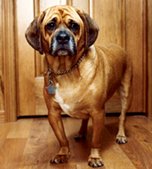
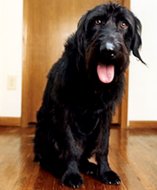
(this just heartens me…. Ewww, my beautiful lab looks like a goat!)
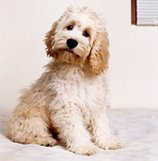
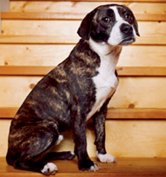
Bob Vetere, president of the American Pet Product Manufacturers Association said, “You’re going to have a real battle here” between hybrid dog breeders and “the purists who say this is all 25th-century voodoo science.” The rift seems to epitomize a peculiarly American tension: between tradition and improvisation, institutions and fads. The American Canine Hybrid Club, one of a growing number of hybrid dog registries, will soon recognize its 400th different kind of purebred-to-purebred cross. There are meanwhile roughly only 400 pure breeds of dog in the world, and the American Kennel Club, the world’s largest purebred registry, has recognized only 155 of them so far in its 123 year-history. It will not be registering Poovanese or Cavoodles any time soon. “What would our registration stand for then?” “Anyone could make up a dog and say, ‘This is a dog!’ ”
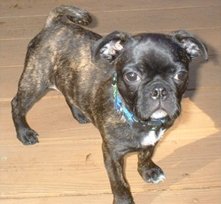
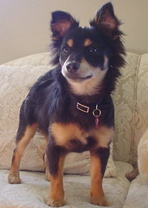
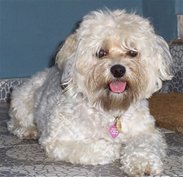
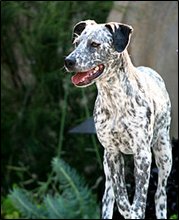
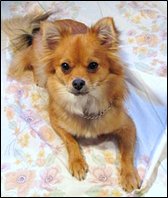
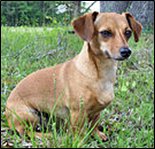
The term "designer dog" has, however, taken on a new meaning, equating fads for crossbreed dogs with other "designer" accessories like purses and shoes. More recently, the term "designer dog" has started to encompass some smaller ("handbag size") purebred dogs, such as the Chihuahua and Pomeranian. Increased public demand for "designer dogs" has resulted in the proliferation of puppy mills cashing in on the fad. Puppy mills are set up to produce puppies as fast as the mother dogs can give birth. The offspring, who may already be in poor health, are shipped long distances to pet shops or are sold through newspapers and the internet. Transportation takes a toll on the pups, and many sicken and die on route.
The primary identifying mark of a crossbred "designer dog' is that the resulting puppies are called by a portmanteau word made up of syllables (or sounds) from the breed names of the two purebred parents, such as schnoodle (Schnauzer and poodle cross). Other purebred breeds are being crossed to provide designer dogs described with an endless range of created labels, such as the Puggle (Pug and Beagle cross). There are even complex crosses (with multiple breeds in recent ancestry) are being labeled in this manner, such as German Chusky (German Shepherd Dog, Husky, Chow Chow).
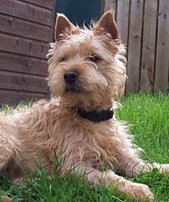
A Lakeland Terrier and a Patterdale Terrier crossbreed may be either a pet or a working terrier. Working dog hybrids are not typically given portmanteau word names.
But crossbreeding for a particular style of designer dog may not work out as intended; instead of the desirable traits, the resulting litter may have a combination of the undesirable traits of the two purebred breeds.
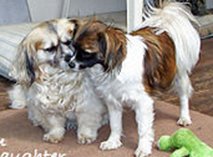
Crossbreeding has not been well studied in dogs. The heritability of the desired trait being bred for (such as a hypoallergenic coat) needs to be known; "Heritability is the proportion of the measurable difference observed between animals for a given trait that is due to genetics (and can be passed to the next generation)." Without that knowledge, it is far less likely for a crossbreeding to consistently achieve an intended appearance or behavior than it is for a purebred breeding. In addition, the goals of dog crossbreeding may be harder to define.
Designer dog breeders are often criticized for being more interested in profitable puppy production than in dog health and welfare. Designer dog puppies sometimes bring higher prices than the purebreds from which they are bred.
Health of dog hybrids depends on their being descended from healthy parents. Breeders who select their breeding stock for cost-effectiveness and who skip health testing for the same reason will not produce puppies that are as reliably healthy as those bred by more conscientious breeders.
Many breeders of designer dogs take advantage of the fact that people are impressed by a pet that offers them an elevated social status, such as other "designer" goods do. "It’s human nature to aspire to own something a little different, a little fancy or in short supply."
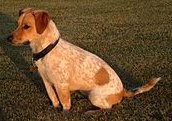
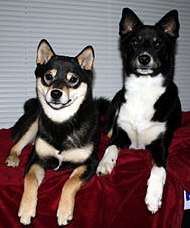
Crossbreed dogs may often inherit size and appearance from only one of their parents, as shown by the male Australian Shepherd/Shiba Inu mixed breed on the right being very similar in appearance and size to the pure bred female Shiba Inu on the left. Despite the Australian Shepherd being nearly 40 pounds/18 kilograms heavier than the Shiba Inu and with very different fur, this hybrid dog inherited both its size and appearance from its mother.
Knowing the disease incidence in the breed, and the genetic history of the individual, is ultimately important in dog breeding. Because some traits are dominant, crossbreed dogs tend to manifest some physical characteristics more frequently than others. Border Collies and some Spaniels, for example, often produce crossbreed offspring with similar coats and ears to their parents. The crossbreed offspring of German Shepherds often have characteristic Shepherd faces and other characteristics. But all crossbred dogs will vary in which characteristics of their purebred parents that they inherit, and may look very different from one another, even within the same litter of puppies.
Crossbreed dogs are not recognized by traditional breed registries, even if both parents are registered purebreds.
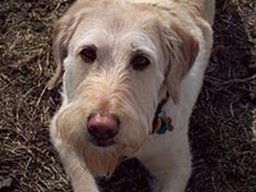
Labradoodles continue to be bred in the United States as they are very saleable for huge prices. (One to two thousand dollars per puppy is a very good price, particularly for a non-AKC registerable mutt or mixed breed). But in most cases, the puppies resulting from these cross breeding’s are no longer hypo-allergenic, dander-less or non-shedding.
Labradoodles, Goldendoodles, all kinds of “oodles”, are showing up in shelters. People who have been promised easy care, non shedding coats are finding that like Poodles, Labradoodles and Goldendoodles need regular grooming. And to make matter worse, because many of the Labradoodles and Goldendoodles are much larger than Standard Poodles, those grooming fees are often much more costly.
A Goldendoodle has more chances getting hip dysplasia. Some of the problems in both breeds are: hip dysplasia, progressive retinal atrophy, epilepsy, allergies, skin and ear problem, and gastric torsion. Breeders of cross mixes rarely do any health tests – genetic or otherwise.
Dogs have always been a product of their times. Designer dogs may only promise what dog breeding always has: the chance to create a custom-designed ideal, a more convenient, useful animal suited to our needs, whatever they happen to be. So, then, to what extent are these new mutts a remedy for what’s wrong with our old dogs and to what extent are they a symptom of what’s wrong with us?

